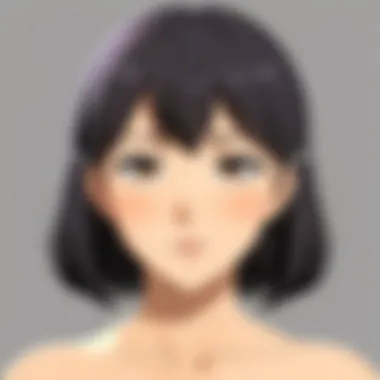Transforming Yourself into an Anime Character


Intro
Transforming into an anime character is more than just a costume. It’s about embodying a persona created in unique worlds. This process is intriguing and multi-faceted, engaging not just physical appearance but also character traits and cultural contexts.
Anime characters often resonate with audiences due to their distinct attributes. They frequently reflect certain ideals or struggles that become relatable. Understanding the essence of these characters is crucial when one attempts to embody them.
In this exploration, we will delve into how to effectively adopt an anime character, focusing on character analysis, costume design, and behavior changes. Each component plays a role in achieving a convincing transformation, allowing an individual to express themselves through an anime lens.
Character Analysis
Before stepping into the character's shoes, a thorough analysis is important. This includes background and storyline significance. Learning about a character’s history, motivations, and relationships within the narrative will enable a more profound connection.
Key points to consider:
- Background: Where do they come from? What experiences shaped them?
- Personality: Are they humorous, serious, or perhaps shy?
- Role: Do they play the hero, the villain, or a side character?
This understanding lays the groundwork for transforming into a character authentically.
Costume Design
Costume design is crucial when creating an anime character persona. The outfit is often a defining feature that connects directly to the character's identity. Research the costume styles through references from the anime or manga. Making or purchasing a costume can often be as significant as the character’s personality itself.
Some key aspects of costume design:
- Material choice: Different fabrics can enhance the character’s look.
- Color schemes: Colors may symbolize different traits or emotions.
- Accessories: Items like weapons or jewelry may hold narrative significance.
An appealing costume does not just showcase the character’s exterior but also expresses the internal traits.
Behavioral Adjustments
To complete the transformation, behavior is paramount. Adopting specific gestures, speech patterns, and attitudes can elevate the embodiment of an anime character. Observe and practice the specific nuances that make the character come alive.
Consider the following:
- Posture: How does the character carry themselves?
- Speech: Is their tone serious or playful? Do they have catchphrases?
- Quirks: Any unique mannerisms?
This phase, while subtle, adds depth to the transformation, making it more than just a visual representation.
Ending
The journey of transforming into an anime character encompasses much more than clothing. By intricately examining the character, designing costumes that reflect personal interpretations, and adjusting behaviors, one can achieve a compelling anime persona. This endeavor allows individuals not only to connect with their favorite characters but also to explore their own identity within this creative framework.
Intro to Anime Characterization
Anime characters often represent complex narratives and cultural meanings. Understanding how to characterize oneself in the realm of anime involves delving into numerous layers of traits, values, and behaviors that define these fictional personas. From the heroic to the enigmatic, each character offers unique elements that resonate with audiences. By exploring these layers, enthusiasts gain insight into personal identity and expression.
Defining Anime Characters
Anime characters are not just illustrated figures; they embody specific traits, moral frameworks, and character arcs. These elements are meticulously crafted by creators to evoke particular emotions and connections. For instance, the iconic character Goku from Dragon Ball Z exemplifies the archetypical hero, characterized by determination and a strong sense of justice.
The visual design, voice, and behavioral mannerisms of these characters generate a framework for fandom engagement. Therefore, individuals who seek to embody such characters must consider these distinct aspects. The array of character types allows for individualized expression, enabling fans to relate in diverse ways. This process fosters a deeper appreciation of not only the character itself but also of one's personality traits that align or contrast with it.
Cultural Context of Anime
The cultural significance of anime cannot be overstated. Originating in Japan, anime has evolved to encapsulate a wide range of influences, from historical narratives to modern societal issues. The characters reflect cultural values such as honor, friendship, and perseverance. By understanding the sociopolitical landscapes that inform these narratives, individuals can appreciate the nuances in characterization and adopt them more effectively.
It is also important to recognize how anime has impacted global cultures. Western fandoms have embraced and reinterpreted these characters, creating a dialogue between cultures. This cultural crossover provides opportunities for fans to explore their own identities through the lens of anime characters. As such, fans not only engage with the characters but also connect with a broader narrative that extends beyond the screen.
"Anime is a reflection of societal values; embodying a character can be a pathway to self-discovery."
In summary, the intricate tapestry of anime characterization involves understanding both the specific traits of characters and the cultural contexts from which they arise. This dual approach allows enthusiasts to explore their identities while enjoying the rich narratives that anime offers.


Understanding Character Archetypes
Understanding character archetypes serves as a fundamental aspect of transforming oneself into an anime character. Character archetypes are essentially predefined models of behavior and personality that resonate with audiences. They simplify complex personalities into recognizable categories, making it easier for fans to relate to and immerse themselves in stories.
Through identifying these archetypes, individuals can choose characters that align with their own traits or aspirations. This choice enhances the depth of the persona one embodies, allowing for a more authentic and enriching experience. It also facilitates discussions within the anime community, as many fans appreciate the specific nuances that come with different archetypes.
Key benefits of understanding character archetypes include:
- Deepened Character Connection: By recognizing an archetype, individuals can establish a deeper emotional connection with the character.
- Guided Transformation: Knowing the traits associated with each archetype assists in crafting a more coherent representation through costume and behavior.
- Intelligent Engagement: Engaging with characters on an archetypal level encourages thoughtful analysis of anime narratives, contributing to richer conversations.
In this section, we will explore the most popular character archetypes and the dynamics of character development that bring these archetypes to life.
Popular Character Archetypes
Within anime, various archetypes often emerge, each with unique characteristics and narrative functions. Some prominent archetypes include:
- The Hero: Often the central character, facing challenges and growing throughout the story.
- The Anti-Hero: A more complex figure, who often operates in moral gray areas, challenging traditional notions of heroism.
- The Sidekick: Provides support and comic relief, often contrasting the primary hero’s traits.
- The Mentor: Wise and experienced, guiding the hero on their journey.
- The Love Interest: Often plays a critical role in character motivation and growth.
- The Rival: Drives the protagonist to improve, often representing an obstacle to overcome.
By understanding these archetypes, one can select a character that resonates with personal experiences or aspirations, making the transformation more meaningful.
Character Development Dynamics
Character development dynamics play a significant role in the portrayal and evolution of anime characters. This process often involves examining how characters grow over time, influenced by their experiences and relationships within the narrative. Factors contributing to character development include:
- Backstory: The character's past often informs their current motivations and behaviors.
- Conflict: Internal or external struggles are pivotal in shaping character arcs and growth.
- Relationships: Interactions with others can catalyze change, whether through friendship, rivalry, or mentorship.
- Cultural Context: The origins of the character, including cultural influences, can add layers of complexity to their development.
Understanding these dynamics allows one to not only embody a character but also appreciate the narrative significance behind their transformation.
These concepts provide insights into how to adopt traits convincingly and meaningfully, facilitating a genuine connection with the character and the broader anime community.
Physical Appearance and Transformation
The matter of physical appearance and transformation is central to the process of embodying an anime character. It delves into the visual representation that significantly influences perception and interaction within both fandom and broader society. By altering one's appearance to resonate with a chosen character, an individual can experience profound personal expression and social connection.
Transforming physically into an anime character involves understanding and selecting key elements that capture the essence of that character. This transformation can enhance the anime experience, allowing individuals to feel more connected to the character's journey, motivations, and emotional depth. The benefits of engaging in such transformation include increased confidence, enhanced creativity, and a deeper appreciation of anime culture.
Choosing the Right Character
Selecting the right character to embody is often the first step in the transformation process. This choice is more than just aesthetic; it encompasses personal connection and identity alignment. Consider whether the character's traits, backstory, or motives resonate with your own values or life experiences. Factors to consider in this decision include:
- Character Popularity: Popular characters often have a more established fan base, which can lead to increased interactions and discussions.
- Character Complexity: Characters with layered personalities may offer more room for creative expression.
- Cultural Relevance: Some characters may hold specific cultural significance that enhances your experience.
Ultimately, the chosen character should inspire a sense of purpose in your transformation.
Costume and Styling Considerations
Costuming is a crucial aspect of transforming into an anime character. A well-chosen costume does more than replicate a character’s outfit; it creates an immediate visual link between the individual and their character. When considering costume and styling, several factors should be taken into account:
- Fabric and Comfort: Choose materials that are both flattering and comfortable, as you may be wearing the costume for an extended period.
- Character Details: Features like colors, patterns, and accessories help to differentiate characters within the same series.
- Customization Options: Tailoring a costume can add a personal touch that shows your dedication.
Researching various approaches to costume-making, whether through DIY methods or purchasing from specialized vendors, is essential.
Makeup and Accessories
Makeup and accessories play a pivotal role in completing the transformation process. This aspect allows for the refinement of physical features to better match the anime character. Here are critical points to consider:
- Makeup Techniques: Learning specific makeup techniques can help achieve the distinctive look of your character. Focus on key elements such as eye shape, lip color, and overall skin tone. Tutorials available on platforms like YouTube can provide essential guidance.
- Signature Accessories: Many anime characters are associated with distinct accessories—hats, glasses, or jewelry—that are critical in creating an authentic look. Adding these can enrich your portrayal.
- Hairstyling: Hair can significantly define a character’s image. Using wigs or hair dye can help in replicating their hairstyle, so choose options that complement your overall appearance.
Transforming physically into an anime character allows individuals to explore new aspects of their identity. It can provide a refreshing outlook on self-expression.
In summary, the physical transformation into an anime character involves careful consideration of various aspects, including the choice of character, costume, and makeup. Each facet contributes to a robust and compelling embodiment of the chosen persona.
Behavioral Traits and Mannerisms


Understanding the importance of behavioral traits and mannerisms is integral to fully embodying an anime character. This section focuses on how one's behavior can enhance or detract from the overall experience of character transformation. The nuances of body language, habitual gestures, and mannerisms contribute significantly to the believability of your portrayal.
Emulating Character Behavior
To become an anime character, one must start by studying the specific behaviors associated with that character. Observing these traits involves an analysis of their reactions during various situations. Consider how a character responds to happiness, anger, or surprise. It is important to recognize that every character has a unique behavioral vocabulary.
- Observation Skills: Watch anime episodes or read manga featuring your character. Note how they speak, their physical movements, and how they interact with others.
- Physical Control: Practice mimicking the character's movements. Lean how they position their body, their walk, and other significant aspects of their physical presence.
By emulating these behaviors, one can mirror the essence of the character. It adds authenticity to your depiction, ensuring you resonate with the audience and those familiar with the specific series.
Voice Modulation and Expressions
Voice plays a crucial role in embodying an anime character. Each character has a distinctive voice that conveys personality traits, emotional states, and background. Tone, pitch, and pace are vital factors in capturing a character's voice.
To practice voice modulation:
- Recording Yourself: Create recordings of your voice while mimicking the character's speech. Compare it to the original voice actors to identify any differences.
- Experimenting with Tone: Adjust your tone to match the emotional content of the character's lines. Make sure you can shift your voice to express joy, sadness, and anger effectively.
- Facial Expressions: Your face needs to communicate the character's feelings. Practice in front of a mirror to understand which expressions work best and become second nature to you.
"True transformation into an anime character requires not only physical appearance changes but a complete alignment of behavior and emotion."
These efforts empower your portrayal, creating a deeper connection with the audience. A well-rounded representation not only entertains but also engages others, creating a memorable interaction within the fandom community. The blend of accurate behavior and voice not only articulates the character but also enhances the transformation experience.
Psychological Aspects of Transformation
The process of transforming oneself into an anime character involves not only physical alterations but also deep psychological engagement. This transformation can serve multiple purposes, such as identity exploration, enhancing creativity, and building community connections. Engaging with an anime character's persona allows individuals to explore traits that they admire or wish to embody. This approach serves as a catalyst for self-reflection and personal growth.
Identity Exploration Through Anime
Anime characters often embody specific traits, ideals, or experiences that resonate with fans. By choosing to adopt a particular character, individuals can explore different facets of their identity. This can range from adopting their confidence to expressing their creativity. Having the opportunity to embody a character in a safe space encourages individuals to consider who they are and who they want to become.
The act of transformation can also propel self-acceptance. For instance, someone who relates to a socially awkward character may find liberation in openly expressing that part of themselves without fear of judgment. Additionally, experimenting with various character traits can be a path to self-discovery. Fans may realize they possess qualities similar to their chosen character, or they may be inspired to cultivate new traits that resonate with them.
Community and Support
The community surrounding anime and cosplay serves as a significant support system for those exploring their identities through transformation. Engaging with like-minded individuals fosters a sense of belonging. These gatherings, whether at conventions or online platforms like Reddit or Facebook, serve as safe spaces for fans to share their experiences and challenges.
Furthermore, support from fellow enthusiasts is crucial. Community members often provide encouragement and helpful feedback on costume designs or character portrayals. This collective experience not only reinforces individual transformations but also cultivates friendships grounded in shared interests.
Ultimately, the psychological aspects of transforming into an anime character touch upon themes of exploration, acceptance, and community. As participants engage in this creative journey, they can gain insights into their identities, supported by a network of fellow fans.
"The most profound journeys often begin with the simplest of transformations."
Engaging with anime characters provides a unique lens through which to understand oneself, grow, and connect with a community that shares similar passions. By navigating this landscape, individuals undertake a journey that is both meaningful and deeply personal.
The Role of Fan Culture
Fan culture plays a crucial role in the dynamics of transforming oneself into an anime character. It provides a vibrant community where individuals can express their passion, share ideas, and learn from one another. At its core, fan culture fosters a shared identity among enthusiasts, creating spaces for dialogue and collaboration. The interaction between fans can significantly enhance the process of character transformation, offering support and inspiration.
Cosplay and Fandom Dynamics
Cosplay, short for costume play, is a significant cultural phenomenon within anime fandom. It involves dressing up as a character from anime, manga, or video games. This practice goes beyond mere imitation; it becomes a form of art, self-expression, and social engagement. Cosplayers often invest substantial time and effort into replicating the intricate details of their chosen characters, from outfits to accessories.
Participating in cosplay can lead to a number of benefits:
- Empowerment: Wearing the costume of a beloved character can instill a sense of confidence.
- Creativity: Crafting and customizing costumes allows for creative expression.
- Community: Attending conventions and events fosters connections with like-minded individuals.
Moreover, the dynamics of fandom enhance the cosplay experience. Fans often organize meetups, collaborate on projects, and share tips on costume creation. They celebrate each other’s efforts, which helps validate their transformations and contributions.
Social Media Influence
Social media has transformed how fans engage with anime culture. Platforms like Instagram, TikTok, and Twitter enable fans to showcase their work and connect with others globally. These platforms are vital for sharing cosplay, art, and character interpretations.
The influence of social media on character transformation is multifaceted:


- Visibility: Fans can gain recognition for their efforts, motivating them to improve and innovate.
- Networking: Social media facilitates connections with creators, industry professionals, and fellow fans, broadening opportunities for collaboration.
- Feedback and Improvement: Sharing work online invites constructive criticism, allowing for ongoing growth and skill development.
"Through social media, the boundaries of fandom have expanded, enabling diverse voices to be heard and fostering a global community devoted to anime."
In summary, fan culture, particularly through cosplay and social media, forms the backbone of the journey toward embodying an anime character. It integrates creativity, community support, and avenues for personal expression, making the transformation process not only a personal journey but also a collective experience.
Impact of Technology on Character Creation
The evolution of technology has significantly influenced the way individuals transform themselves into anime characters. It has provided new methods to create, refine, and embody specific character traits in a manner that was not possible in the past. Enhancements in digital tools available today present opportunities for deeper engagement with the essence of a character.
Digital and Virtual Characterization
Digital and virtual characterization refers to the use of advanced software and applications designed to create accurate representations of anime characters. These technologies allow fans to customize their avatars or personas and give them life in virtual spaces. The possibilities are vast and include virtual reality, augmented reality, and 3D modeling.
- 3D Modeling Software: Tools like Blender or Maya enable users to realize their character designs. Customizable options help in creating precise details like facial features, costumes, and accessories.
- Avatar Creation Platforms: Websites such as VRChat or Second Life provide environments where users can assume the identities of anime characters. Users can showcase their appearances while interacting with others.
- Character Animation: Software like Live2D allows for creating animated models. This makes the character more dynamic, giving expressed emotions through animations.
- Game Engines: Unity and Unreal Engine facilitate immersive experiences with intricate character interactions, further enhancing transformation into a persona.
Benefits of Digital Characterization
The implementation of these technologies offers several benefits:
- Enhanced Personalization: Fans can fully customize their character according to their liking, aligning closely with the source material.
- Engagement in Virtual Spaces: Technology allows for interaction with other fans in a shared virtual landscape.
- Expression and Exploration: Digital tools empower users to explore their identities via their chosen characters, promoting self-discovery in a safe environment.
However, it is essential to consider several factors before diving into technological transformations. Users should remain aware of the cultural significance of the original characters and strive for appreciation rather than mere replication. As noted in the anime community:
"Respect for the characters and their backgrounds is paramount. Appropriating without understanding can lead to misunderstandings and disrespect."
Ethical Considerations
Navigating the process of transforming oneself into an anime character involves not only personal expression but also a heightened awareness of ethical considerations that accompany this transformation. It is essential to reflect deeply on the implications of cultural representation, as one's choices can have significant effects on communities associated with the source material. Being conscious of these factors encourages a respectful engagement with the intricate world of anime and its diverse narratives.
Cultural Appropriation vs. Appreciation
The line between cultural appropriation and appreciation is often thin and contentious, especially in the realm of anime. Cultural appropriation refers to the adoption of elements from one culture by members of another culture, typically without permission and in a manner that fails to respect the source culture's significance. On the other hand, appreciation emphasizes understanding and honoring the origins and nuances of a culture.
Understanding this distinction is crucial when embodying an anime character. For instance, adopting attire or mannerisms from a cultural background that is not one's own—without proper understanding or respect—could be deemed inappropriate. Instead, engaging with these cultures through education, respectful dialogue, and community involvement can foster an environment of appreciation.
Key Points to Consider:
- Research and Acknowledge: Before embodying a character, conduct thorough research on the cultural background of that character. Understand its importance and context.
- Seek Permission: Where possible, engage with cultural representatives to gain insights and perspectives. This can include artists, scholars, or community members relevant to the culture depicted.
- Promote Inclusivity: Strive to promote diversity and inclusivity within your cosplay or character portrayal. This cultivates respectful representation across various dimensions.
In summary, the goal is to elevate cultural narratives through appreciation rather than appropriation.
By balancing individual expression with cultural sensitivity, anime enthusiasts can create a more inclusive and understanding environment. This awareness not only enriches the experience of transforming into an anime character but also honors the diverse heritage in the anime community.
Culmination
Transforming into an anime character is more than just superficial appearance changes; it is a nuanced journey that intertwines personal identity exploration and cultural appreciation. The importance of this transformation lies in various significant elements:
- Self-Expression: Emulating an anime character allows individuals to express facets of themselves that they might not easily showcase in everyday life. It provides an avenue for creativity and personal interpretation of characters.
- Community Connection: Engaging in this practice connects like-minded individuals, offering support and a shared sense of identity. Through conventions or online platforms like Reddit and Facebook, fans can foster relationships that may lead to deeper discussions and collaborations.
- Cultural Understanding: Delving into the attributes of anime characters fosters a greater appreciation for the cultural contexts from which these characters emerge. When individuals immerse themselves in various personas, they often gain insights into the values and narratives represented in anime and manga.
- Empowerment: The act of transformation can empower participants by enabling them to take control over how they are perceived. It can boost confidence and encourage exploration of different traits and behaviors.
"To become an anime character is not just to wear a costume; it is to embrace a narrative and become part of a larger community."
- Psychological Exploration: Engaging in this transformation often encourages individuals to reflect on their own identities, thus providing them with an opportunity for personal growth. This aspect highlights the psychological depth of portraying an anime character, going beyond aesthetics to deeper inner exploration.
As we conclude, the journey of transforming into an anime character fosters self-discovery, community interaction, cultural appreciation, and a chance to explore different aspects of personality. It is a rewarding process that invites participants to not only embody a character but to also embark on a journey of understanding themselves and their place within the broader anime fandom.
Personal Reflection on the Journey
Reflecting on the journey of becoming an anime character, one can notice how this process blends creativity with introspection. Each character carries challenges and triumphs that may resonate with an individual's life experiences. This connection can lead to profound personal growth.
Starting this journey involves thoughtful consideration, as individuals must explore which character aligns with their own values or aspirations. This reflection might involve asking oneself:
- What traits do I admire in this character?
- How do their challenges mirror my life?
- What aspects of my personality can I express through them?
Such questions are central to this transformative experience. As one undergoes the physical transformations, be it through costumes, makeup, or mannerisms, there’s also an emotional and psychological shift that accompanies these changes.
This dual transformation encourages believers to step outside their comfort zones, engage with new communities, and perhaps even participate in events that celebrate this deep-rooted culture. It is rewarding to see how these interactions contribute to personal echoes of empowerment and belonging.
In summary, the journey reflects not just superficial changes but an intertwined weaving of identity, emotional expression, and community engagement, all of which contribute to our understanding of anime as a richer concept.







